new posts in all blogs
Viewing: Blog Posts Tagged with: Alarcon, Most Recent at Top [Help]
Results 1 - 6 of 6
How to use this Page
You are viewing the most recent posts tagged with the words: Alarcon in the JacketFlap blog reader. What is a tag? Think of a tag as a keyword or category label. Tags can both help you find posts on JacketFlap.com as well as provide an easy way for you to "remember" and classify posts for later recall. Try adding a tag yourself by clicking "Add a tag" below a post's header. Scroll down through the list of Recent Posts in the left column and click on a post title that sounds interesting. You can view all posts from a specific blog by clicking the Blog name in the right column, or you can click a 'More Posts from this Blog' link in any individual post.

By: Maryann Yin,
on 4/14/2015
Blog:
Galley Cat (Mediabistro)
(
Login to Add to MyJacketFlap)
JacketFlap tags:
Toni Morrison,
Resources,
Sherman Alexie,
Robie Harris,
Marjane Satrapi,
Henry Cole,
Stephen Chbosky,
Raina Telgemeier,
Justin Richardson,
Peter Parnell,
Jaycee Dugard,
Fiona Staples,
Khaled Hosseini,
Brian Vaughan,
Libraries,
Add a tag
 The American Library Association (ALA) has released its annual list of the most frequently challenged library books of the year. Sherman Alexie’s National Book Award-winning young adult novel, The Absolutely True Diary of a Part-Time Indian, claimed the top spot.
The American Library Association (ALA) has released its annual list of the most frequently challenged library books of the year. Sherman Alexie’s National Book Award-winning young adult novel, The Absolutely True Diary of a Part-Time Indian, claimed the top spot.
Throughout the year 2014, the ALA Office for Intellectual Freedom received 311 reports of challenged books. Click here to check out an infographic that explores “Banned Books Through History.”
Here’s an excerpt from the ALA report: “The lack of diverse books for young readers continues to fuel concern…A current analysis of book challenges recorded by ALA’s Office for Intellectual Freedom (OIF) from 2001 – 2013, shows that attempts to remove books by authors of color and books with themes about issues concerning communities of color are disproportionately challenged and banned. A challenge is defined as a formal, written complaint filed with a library or school requesting that a book or other material be restricted or removed because of its content or appropriateness.”
10 Most Frequently Challenged Library Books of 2014
1. The Absolutely True Diary of a Part-Time Indian by Sherman Alexie
2. Persepolis by Marjane Satrapi
3. And Tango Makes Three by Justin Richardson and Peter Parnell with illustrations by Henry Cole
4. The Bluest Eye by Toni Morrison
5. It’s Perfectly Normal by Robie Harris
6. Saga written by Brian Vaughan and illustrated by Fiona Staples
7. The Kite Runner by Khaled Hosseini
8. The Perks of Being a Wallflower by Stephen Chbosky
9. A Stolen Life by Jaycee Dugard
10. Drama by Raina Telgemeier
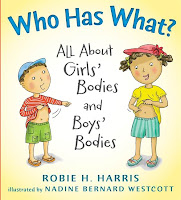
WRITING SIMPLE—WRITING HONEST—MAKING CHOICESCreating Nonfiction for Our Youngest Children I should have known better. But for a few days, I was fooled again, as are so many of us, when we think about writing nonfiction for very young children. “Simple,” one friend told me. “You’re writing a book for little kids. They don’t need a lot of information.” A colleague who writes for older children said, “Only about fourteen pages of text, and a couple of short paragraphs per page. And oh yes, two of your characters talk. Can’t take all that long… can it?” That question sent me right back to reality as I answered in my most calm voice, “Yes, it can,” At least, it takes me a very long time to write any picture book for young children.” And yes, it did. It took me a lot longer than I had expected to write my newest nonfiction picture book for very young children—WHO HAS WHAT? All About Girls’ Bodies and Boys’ Bodies, illustrated by Nadine Bernard Westcott and published by Candlewick Press. The idea for this book came to me one day when I heard a young child sing, “Head, shoulders, knees and toes, knees and toes. And eyes, and ears, and mouth,
and nose…” While listening to the child, it crossed my mind that not all parts of the body are named in that song and I wondered what that omission meant for young children. And that’s what led to my writing a book for them that would name all the parts of the body, including the genitals. I wanted to write this book because it matters that children know and understand at an early age that every part of the body, including the genitals, is a perfectly healthy and perfectly normal part and that there is nothing shameful or dirty about one’s private body parts or even knowing and saying the names of those parts such as “the vagina” or “the penis.” “Okay,” I thought to myself as I began to collect and outline the information that would be in this book. “Easy to do. Just name the parts. Label them. The illustrator will create charming art and labels for each body that will make naming all the parts make fun and easy for young children.” However, it turned out that this book was neither simple nor easy to create. I did know from the get-go that the text had to be short. But only a few days after I began writing, I realized that the text could not be all that short. It became clear that there were some explanatory details that had to be added to help young children understand the information that I was including in this book. For example: in order to help young children know just where some of these parts are located—in particular their genitals and the fact that your genitals are what make you either a girl or a boy—I knew I would have to include more information and that would result in a longer text. I wondered if the amount of text would be too long for a young child. I also worried that I was underestimating a young child’s yearning to know. A few days later, I thought about the fact young children are fascinated by—to use their language—“pee” and “poop.” I suspected that they would want it confirmed that the opening where pee comes out is located in different places for girls and boys and that poop comes out of the same opening for both boys and girls. I also realized that it would be helpful to include boys’ and girls’ “inside parts”—parts that they can’t see—parts that also make them either a boy or a girl. Soon, I was writing about gender differences between male and female anatomy in a book for young children. I wondered if this was “too much information.” I worried I that the more information I added, the more complicated the text would become, resu
by Robie H. Harris pictures by Harry Bliss Candlewick 2004 Okay, this book sort of freaked me out.First, this is one of those books that gets shelved with the "other issues" books that parents use as object lessons they'd rather not teach themselves. You know, rather than talk to kids about how to deal with bullies or first-day-of-school or other traumas of modern childhood, parents sit their
 In my regular “Everyday Poetry” column for Book Links magazine, I wrote about pairing and comparing poetry in the most recent (January, 2008) issue. It’s entitled “Pairing Poems Across Cultures” and here’s a brief excerpt:
In my regular “Everyday Poetry” column for Book Links magazine, I wrote about pairing and comparing poetry in the most recent (January, 2008) issue. It’s entitled “Pairing Poems Across Cultures” and here’s a brief excerpt:
Seeking out the poetry of parallel cultures enables children to see firsthand both the sameness and the differences that make the human landscape so dynamic and fascinating. Poets of color are using the language, experiences, and images of their cultures in ways that are fresh and powerful. The special succinctness of poetry is also appealing, and powerful points about prejudice, identity, and cultural conflict can be made in very few words.
Sharing poems in pairs can help children to engage their critical thinking skills by comparing the topics, themes, points of view, or language of the two poems. Selecting poems that reflect cultural details adds an additional layer of meaning and interest. Of course, reading and enjoying the poem for its own sake is the first step. Responding, comparing, and analyzing often follow naturally when children read, hear, and recite poetry together. Repeated readings could incorporate choral reading arrangements and child participation. Here is one sample poem pairing:
Compare Poems about Poetry
• “Wish” by Linda Sue Park, from Tap Dancing on the Roof; Sijo Poems (Clarion, 2007)
• “A Blank White Page” by Francisco X. Alarcón, from Iguanas in the Snow and Other Winter Poems / Iguanas en la Nieve y Otros Poemas de Invierno (Children’s Book Press, 2001)
“Wish”
by Linda Sue Park
For someone to read a poem
again, and again, and then,
having lifted it from page
to brain-- the easy part--
cradle it on the longer trek
from brain all the way to heart.
and
“A Blank White Page”
by Francisco X. Alarcón
A blank white page
is a meadow
after a snowfall
that a poem
hopes to cross
Look at how poets have captured the beauty of poetry itself and what a poem can be and do. Newbery Medalist Linda Sue Park explores the Korean poetic form of sijo to describe poetry’s impact, “from brain all the way to heart,” while Francisco X. Alarcón uses images of “a meadow / after a snowfall” to describe the page a poem is written upon. Children can try writing their own “definition” poems modeled on the sijo or free-verse format of these two examples. Next, create a “dictionary” anthology of all of their “defining” poems.
Picture credit: ala.org/booklinks

By:
Elaine Anderson,
on 11/14/2007
Blog:
Fahrenheit 451: Banned Books
(
Login to Add to MyJacketFlap)
JacketFlap tags:
Robie Harris,
Carolyn Mackler,
It's Not the Stork,
The Earth My Butt,
Sex Kittens,
Maryrose Wood,
Robie Harris,
Carolyn Mackler,
It's Not the Stork,
The Earth My Butt,
Add a tag
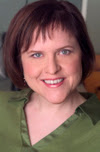 Maryrose Wood reports that she will be speaking at the National Council of Teachers of English Annual Convention concerning book challenges and the First Amendment rights of students in the United States. She is one of three authors who have had their books challenged recently.
Maryrose Wood reports that she will be speaking at the National Council of Teachers of English Annual Convention concerning book challenges and the First Amendment rights of students in the United States. She is one of three authors who have had their books challenged recently.
I'll be reminiscing about the madcap Sex Kittens and Horn Dawgs Fall in Love book challenge in Florida. The panel will also include the wonderful authors Carolyn Mackler (The Earth, My Butt, and Other Big Round Things) and Robie Harris (It's Not The Stork!), both of whom have had their own run-ins with people who have somehow not yet gotten around to reading the Constitution. (I know, I know, it's only been a couple of hundred years...)
Date:Friday, November 16th
Time: 11:00 AM–12:15 PM
Place: Jacob K. Javits Convention Center
1E07, Level 1
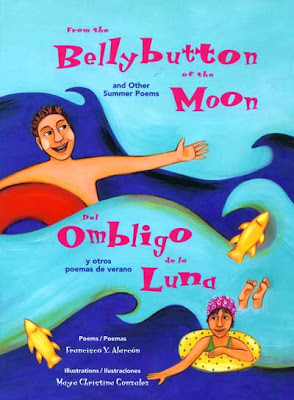 From the Bellybutton of the Moon / Del Ombligo de la Luna
From the Bellybutton of the Moon / Del Ombligo de la Luna
1998
Angels Ride Bikes / Los Angeles Andan en Bicicleta
1999
Iguanas in the Snow / Iguanas en la nieve
2001
by Francisco X. Alarcon
illustrated by Maya Christina Gonzalez
Children's Press Books
I wanted to discover a new voice, some new poetry. I wanted it to be my discovery. Not necessarily something new, not something I could trumpet to the world as the next big thing, but something out there that hadn't crossed my path. There's a lot out there.
I went looking for a new voice in children's poetry and initially I went to the Poetry Foundation website because they had anointed the first Children's Poet Laureate last fall. Given my goal that might sound like cheating but what I wanted was to know what was already out there. I didn't want to "find" what someone else was pushing. Turns out I needn't have worried, there wasn't really anything there.
I jumped around on the Internet and landed on a California poet named Francesco X. Alarcon. In simple two- and three-line stanzas he was writing about the small moments of barrio life, of growing up in California, of the migrant and Mexican American experience. I couldn't find anything in bookstores and was able to track down three of his four seasonal collections.
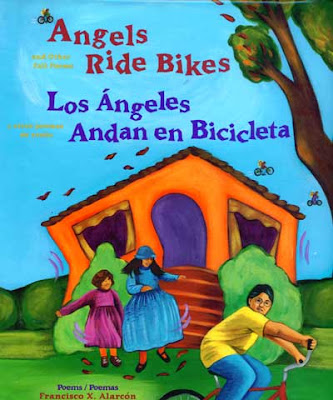 Los Libros / Books
Los Libros / Books
pasaportes / oversized
de talla mayor / passports
que nos permiten / that let us
viajar / travel
a dondequiera / anywhere
cuandoquiera / anytime
y no dejar / and keep on
de sonar / dreaming
In Alarcon's poems a family dressed in army surplus cold weather parkas become the iguanas playing in the rarely-seen snow. There is an ode to the man who twirls his mustache and sells popsicles from a cart at the end of the alley on a summer day. In his poems the imported palm trees of Southern California cha-cha-cha during earthquakes. The colorful illustrations that accompany the poems are in the bold colors and flattened surfaces reminiscent of the Mexican mural movement. The poems and their presentation are perfect for emerging readers who are ready for poetry beyond the rhymes, beyond nonsense, who might be looking for their own poetic inspiration.
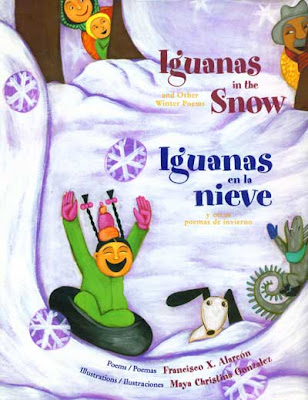 Para escribir poesia / To Write Poetry
Para escribir poesia / To Write Poetry
debemos / We must
primero tocar / first touch
oler y soborear / smell and taste
cada palabra / every word
That pretty much is the complete lesson plan for a poetry unit. Not that you'd find an administration that would accept it as one. I didn't expect to uncover a great new voice but I was happy to have been so successful in a single casual outing.
* * * * *
April, as may remember, was National Poetry Month. While many in the kidlit blogosphere were doing many wonderful things with the month I just wasn't feeling it this time around.
I did, however, hold a secret hope that we would be seeing some more high-profile books and event surrounding National Poetry Month. The source of my hope was the naming of Jack Prelutsky as the Children's Poet Laureate back in the fall by the Poetry Foundation. At the time I imagined that Prelutsky would seize the opportunity to give children's poetry a higher profile, something along the lines of what Robert Pinsky did when he raised the national level of discussion about poetry with his Poet Laureate status. I'm not saying Prelutsky would have to hold a regular gig on NPR, or hold down the fort at Slate.com, or create the Favorite Poem Project, but then again, why couldn't he?
I guess I was hoping that when National Poetry Month rolled around we'd be hearing more from old Jack. Perhaps I just always happened to be out of earshot, perhaps he was out there discovering and promoting new children's poets, making a case for better rhymes or even for an examination of serious poetry for children. I'm not talking about having to track the man down on the Poetry Foundation website for a couple of puff entries but something a little more in our faces.

Oh, wait, he had two of his own book released during National Poetry Month, Good Sports and Me I Am, and it looks like his various publishers went back and dusted off all his older titles. And just this week another new Prelutsky book hit the shelves, In Aunt Giraffe's Green Garden, only this one came out with a Hollywood style name-above-the-title cover that proudly proclaimed "Jack Prelutsky, Children's Poet Laureate".
Huh.
Don't get me wrong, Jack Prelutsky is a fine children's poet and has dozens of very popular books to prove it. The recognition isn't undeserved, though it is unnecessary. I guess I assumed that the title and the position was meant to be something more than a marketing tag and a lifetime achievement laurel.
One needs to be enchanted before being disenchanted, so I guess I'll have to settle for disappointed.
 The American Library Association (ALA) has released its annual list of the most frequently challenged library books of the year. Sherman Alexie’s National Book Award-winning young adult novel, The Absolutely True Diary of a Part-Time Indian, claimed the top spot.
The American Library Association (ALA) has released its annual list of the most frequently challenged library books of the year. Sherman Alexie’s National Book Award-winning young adult novel, The Absolutely True Diary of a Part-Time Indian, claimed the top spot.









Great post, Robie. It's perfectly amazing how hard it is to write simple, isn't it?
I read WHO HAS WHAT with great pleasure. Now I'm dying to know what was left out. Congratulations Robie! It's a must read for young and somewhat old.